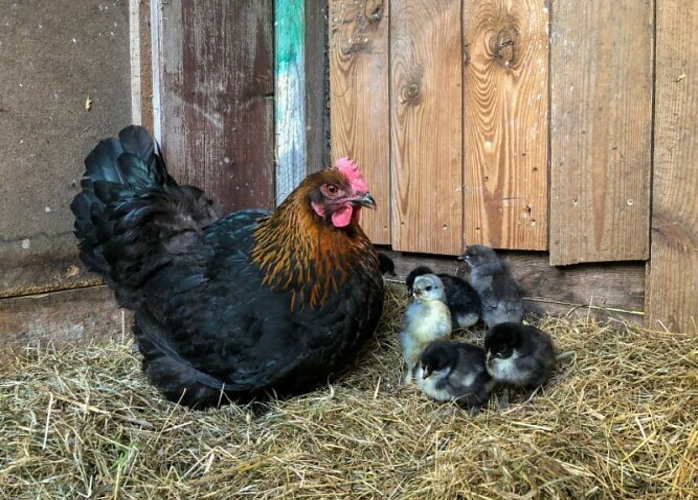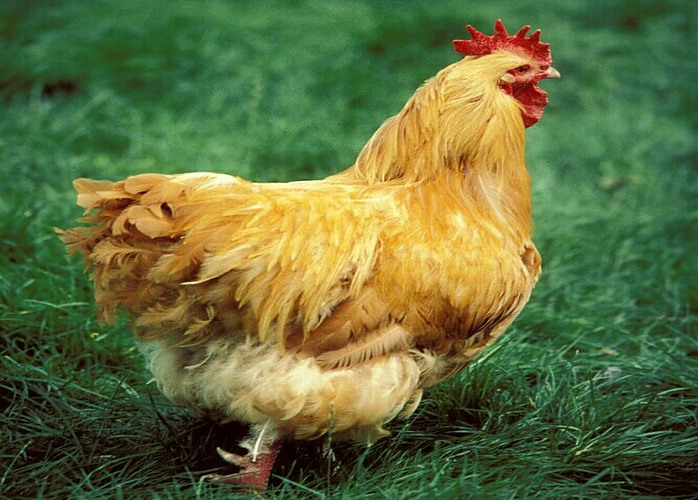
I’m going to introduce you to a real gem in the poultry world, the Marans chicken, a breed with a prestigious reputation and distinctive features that make it stand out in the coop. This isn’t just about their striking plumage or the well-known dark chocolate eggs they lay; it’s also about the breed’s fascinating history and enduring appeal.
You’re going to find out about their top attributes, including those famous dark brown eggs that fetch a pretty penny and their diverse feathering that adds a dash of elegance to any flock.
Not Just Another Chicken
The Marans chicken isn’t just another bird on the farm; it’s a breed that’s gaining momentum among chicken lovers and small-scale farmers alike, and for good reason.
When I’m considering adding another chicken to my flock, I want it to be different from the others while maintaining a decent yield of eggs: I consider aesthetics and utility, and the Marans chicken impressively checks both boxes.
As we explore the characteristics that make the breed so admired, from their egg-laying capabilities to their temperament, remember that choosing this breed could spruce up your poultry collection visually but with a reliable, quality yield.
So, are you ready to learn more about the breed that’s capturing the hearts of poultry lovers around the world?
Let’s set the stage for understanding where the Marans come from and how they became the famed breed they are today, which leads us right into the roots of these beautiful birds.
The Roots of Marans Chickens Find us in France
If you’re curious about where the Marans chicken comes from, you’re about to find out. Touted for their beautiful dark eggs, these birds hail from the quaint port town of Marans in western France. It’s there, nestled by the seaside, that they began their journey from local secret to international sensation.
You might be wondering how a simple barnyard fowl could garner so much attention.
Interestingly, the story of the Marans breed includes a quick trip to China. In the 1920s, local fowl were crossbred with Langshans, a breed from China known for its size and feathered legs.
This mix infused the Marans with a diversity of feather colors and their signature robust physique.
Over the years, the breed has expanded to include several recognized variations, from the classic Black Copper to the intriguing Silver Cuckoo Marans.

Each type brings its zest to the table, literally with the eggs and figuratively with their contribution to poultry variety.
What’s more, the evolution of the Marans didn’t stop at French borders. Poultry hobbyists around the globe took a shine to these charming chickens, leading to the establishment of breed standards to preserve their distinctive traits.
This careful cultivation has secured the Marans’ reputation as a coveted breed among chicken connoisseurs and farmsteads alike.
The Multifaceted Marans
Marans chickens are a true spectacle of utility. They’re striking in their plumage and impressive in their dual-purpose capabilities.
Now, when I say ‘dual-purpose,’ I’m talking about both egg and meat production. If you’re wondering, ‘Can Marans deliver the goods on both fronts?’ the answer is a resounding YES.
Marans are renowned for their rich, chocolate-colored eggs, and their laying prowess doesn’t disappoint. Many keepers vouch for the breed’s consistent egg-laying, even in less-than-ideal conditions.
When it comes to their table qualities, Marans also score high. This breed provides a good amount of meat, and their historical use throughout France attests to their desirability as a hearty meal.
But it isn’t just the quantity of the meat; the flavor is equally praised, making Marans chickens a favorite for those who value taste alongside productivity.
Marans Hardiness, Temperament, and Foraging Ability
You might be thinking, ‘Ok, they’re good layers and meat producers, but how do they fare in different climates?’ Here’s the scoop: Marans are robust.
Thanks to their dense feathering, They have a notable resilience against the cold. Plus, Marans don’t mind the heat either, assuming they have access to shade and water. Their versatility in various climates is just another feather in their cap.
Now, let’s chat about temperament. Marans are generally docile and friendly, mixing well into the backyard scene without much fuss. They’re not looking to stir up trouble, which makes them great neighbors to other breeds you might have wandering around.
As for foraging, Marans are natural-born seekers. They’re happy to hunt and peck around, which can help them find extra nutrients and reduce feed costs.
Not to mention that they’re showing resilience against many common avian diseases, meaning a flock of Marans won’t have you running to the vet every so often.
There aren’t many breed-specific care needs to highlight for Marans, but they do appreciate good living conditions like any other chicken. Adequate space, a clean coop, and a balanced diet—stick to these basics, and your Marans should thrive.
To sum it up, Marans are like those well-rounded individuals who excel in several areas, making them an all-around asset to your poultry pursuits.
Marans Chickens, Beyond the Glossy Feathers

So, we’ve taken a closer look at the Marans chicken, unearthing what makes this breed quite exceptional. From their lustrous, chocolate-brown eggs to their adaptable nature, the Marans chicken is a good choice for experienced and novice poultry keepers.
I’m hoping I’ve highlighted why the Marans chicken could be more than just another bird for your coop. Their dual-purpose capabilities, hardiness in diverse climates, and amiable temperament offer a full package to anyone looking to diversify their flock or start a new poultry venture.
Beyond their practical advantages and striking looks, keeping Marans chickens can be seen as an act of heritage preservation. By choosing this breed, you’re championing biodiversity and enhancing the gene pool, contributing to poultry breeds’ overall health and longevity.
If you’re contemplating adding Marans to your backyard, consider the joy of watching these birds forage with gusto, the pride in obtaining robust and richly-colored eggs, and the peace of mind knowing they’re a breed with few special care demands.
Don’t rush your decision; I encourage you to ponder how Marans could fit into your unique setting.
In the end, whether you’re drawn to their storied past, elegant plumage, or utility, the Marans breed is a worthy and rewarding choice for your flock. These feathered gems might just become the highlight of your poultry-keeping journey.
My Pet Chicken
I don’t usually single out a hatchery for its breed specialization, but I would like to give a shout-out to My Pet Chicken hatchery for their love for the Marans chicken. If you are interested in this lovely chicken, take a look at them at My Pet Chicken here.
Thanks for reading. Please let me know about your Marans experience in the comments below. My readers and I appreciate it.
Dave
Chickenmethod.com
